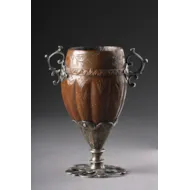Portuguese Colonial South American Silver Mounted Carved Cocquilla Nut Chalice
A Portuguese Colonial South American Silver Mounted Carved Cocquilla Nut Chalice
The Cocquilla nut decorated with flowering tendrils
First half of the 17th Century
Size: 11.5cm high, 9.5cm wide (max) – 4½ ins high, 3¾ ins wide (max)
The Cocquilla nut decorated with flowering tendrils
First half of the 17th Century
Size: 11.5cm high, 9.5cm wide (max) – 4½ ins high, 3¾ ins wide (max)
A Portuguese Colonial South American Silver Mounted Carved Cocquilla Nut Chalice
The Cocquilla nut decorated with flowering tendrils
First half of the 17th Century
Size: 11.5cm high, 9.5cm wide (max) – 4½ ins high, 3¾ ins wide (max)
The Cocquilla nut decorated with flowering tendrils
First half of the 17th Century
Size: 11.5cm high, 9.5cm wide (max) – 4½ ins high, 3¾ ins wide (max)
Cocquilla nuts first came to Western Europe in the mid 16th century and became a favourite material for small turned and carved objects, many of which in the 16th and 17th centuries were intended for religious use. The nut is the fruit of the Brazilian 'piassaba' palm which grows extensively down the eastern side of South America in swampy ground.
Although used to elevate Christian worship these exotic objects, which were very popular in European Kuustkammers, were produced in what the priests believed to be 'pagan' countries. The church and monastery treasures grew rich on the influx of these luxury items from South America, Africa and the Orient.
Although used to elevate Christian worship these exotic objects, which were very popular in European Kuustkammers, were produced in what the priests believed to be 'pagan' countries. The church and monastery treasures grew rich on the influx of these luxury items from South America, Africa and the Orient.
Finch and Co
Private London collection
Private London collection
Portuguese Colonial South American Silver Mounted Carved Cocquilla Nut Chalice

SOLD
YOU MAY ALSO LIKE

